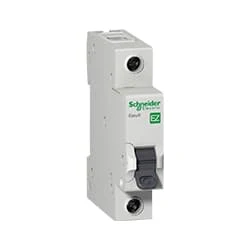Forward Reverse Motor Control diagram:
This Diagram shows how to make Forward Reverse Motor Control Wiring Diagram. In this circuit, we use an SP MCB ( Single Pole Miniature Circuit Breaker ), a stop switch, a start switch, three timers, and two magnetic contactors. First, we need to connect the SP MCB with the phase line, then connect the stop switch, start switch, timers, and contractors. Then connect the neutral wire to all components. This circuit is ready for use if you want to know more about this circuit please check our youtube video below the post.
Diagram of Motor control wiring:
Components Need for this Project:
You can get the components from any of the sites below:
- Timer [See Buy Click Amazon]
- SP MCB [See Buy Click Amazon]
- Stop Switch [See Buy Click Amazon]
- Start Switch [See Buy Click Amazon]
- Contactor [See Buy Click Amazon]
Read Also:
Components used to make the Motor wiring:
01. Timer
 |
| Fig 2: Timer |
Timer is a specialized type of clock used for measuring specific time intervals.An electromechanical cam timer uses a small synchronous AC motor turning a cam against a comb of switch contacts. This type of timer often has a friction clutch between the gear train and the cam, the cam can be turned to reset the time.A simple example of the first type is an hourglass. Working method timers have two main groups: hardware and software timers.Most timers give an indication that the time interval that had been set has expired.
02. SP MCB
 |
| Fig 3: SP MCB |
MCB SP means single pole it protects only one phase switching. MCB (Miniature Circuit Breaker) Curswitch is the most basic general-purpose switch that you use to control a light or another device from one location. These Switches Have Two Brass-Colored Screw Terminals Connected to the hot Power Source Wires. (MCB) For any Distribution Board, the Protection System Must be Used in The Incomer. Phase and Neutral Single Phase Supply to break. 120-volt circuits, 15-20 amp single pole breaker is typically used.
03. Stop Switch
 |
| Fig 4: Stop Switch |
Indicates the contacts of switches or automatic actionable devices. Simply put, the push switches, magnetic contactors, and relays that we use in the factory Normally have Close Contact exists. At this moment the switch will be in normally closed condition. Because already he is sitting close. When turned off the contact will open. To make ladder logic you need to understand NC contact. As already explained. The switch contact is already closed in NC. That is enough to understand.
04. Start Switch
 |
| Fig 5: Start Switch |
The operator switch has its contact in Normally Open condition. To make Ladder Logic you need to understand NO contact. A Classic Switch has one Input And one Output. In "No Switch," YoungBoy Raps About Ammunition, Murder, Firearms, and Firearm Attachments Such as a Switch. The contact of the switch whose contact is already open is NO. That is enough to understand. no switch in a circuit, then the circuit will not function as intended. to write a program such that when the red light is on, This switch is now in normally open condition. When you push the switch it will close and the red light will turn on.
05. Contactor
 |
| Fig 6: Contactor |
A magnetic contactor is an electrical device used for load control, automation, and protection. It is much like a magnetic reel. However, relays are generally used for low power and voltage, on the other hand, when we think of high power, these heavy-duty contractors only come to mind. It basically works by switching the load on and off. It has 3 terminals whose inputs are denoted as L1, L2, L3, and outputs as T1, T2, and T3. The circuit of the load is made in automation mode or protection using auxiliary contacts. It has two types of terminals. 1) Normally Open (NO). 2) Normally Closed (NC).
Thank You for visiting the website. Keep visiting for more Updates.
Frequently Asked Questions
A forward or reverse magnetic motor starter was constructed from 2 regular contactors and is installed with a mechanical interlock that prevents both coils from pulling in simultaneously. They were connected so that under normal conditions, one coil would connect L-1 with T1, L-2 with T-2, and L-3 with T-3.
Forward and reverse connection motors can be used in various applications where you need to control the direction of the rotation. Some common examples include conveyor systems, winches, cranes, or other machinery where the ability to control both forward and reverse motion was necessary.
Working principle: + When the main contact of the KF contactor is closed, the motor runs in the forward direction. Conversely, when the main contact of the KR contactor is closed, the motor is energized to rotate in the opposite direction.
Once started, a single-phase induction motor would happily run in either direction. To reverse it, we need to change the direction of the rotating magnetic field produced by the running and starter windings. This could be accomplished by reversing the polarity of the starter winding.
This could be accomplished by using two contactors, one for the forward or CW rotation and one for the reverse and CCW rotation. The forward and reverse contactors were mechanically interlocked i.e., if one of them was closed the other could not close.


Post a Comment
Do leave your comments